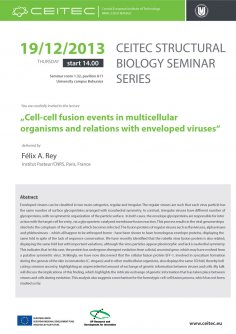WHEN: December 19, at 2 p.m.
WHERE: lecture room 132, pavilion A11, University Campus Bohunice, Brno
Abstract:
Enveloped viruses can be classified in two main categories, regular and irregular. The regular viruses are such that each virus particle has the same number of surface glycoproteins arranged with icosahedral symmetry. In contrast, iirregular viruses have different number of glycoproteins, with no symmetric organization of the particle surface. In both cases, the envelope glycoproteins are responsible for interaction with the target cell for entry, via a glycoprotein-catalyzed membrane fusion reaction. This process results in the viral genome deposited into the cytoplasm of the target cell, which becomes infected. The fusion proteins of regular viruses such as flaviviruses, alphaviruses and phleboviruses – which all happen to be arthropod-borne - have been shown to have homologous envelope proteins, displaying the same fold in spite of the lack of sequence conservation. We have recently identified that the rubella virus fusion protein is also related, displaying the same fold but with important variations, although the virus particles appear pleomorphic and lack icosahedral symmetry. This indicates that in this case, the protein has undergone divergent evolution from a distal, ancestral gene, which may have evolved from a putative symmetric virus. Strikingly, we have now discovered that the cellular fusion protein EFF-1, involved in syncytium formation during the genesis of the skin in nematodes (C. elegans) and in other multicellular organisms, also displays the same 3D fold, thereby indicating common ancestry, highlighting an unprecedented amount of exchange of genetic information between viruses and cells.
The talk will discuss the implications of this finding, which highlights the intricate exchange of genetic information that has taken place between viruses and cells during evolution. This analysis also suggests a mechanism for the homotypic cell-cell fusion process, which has not been studied so far.
Poster to download can be found HERE.








